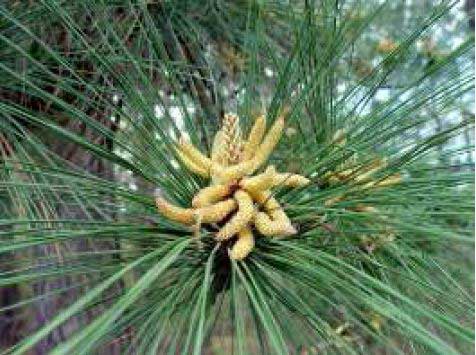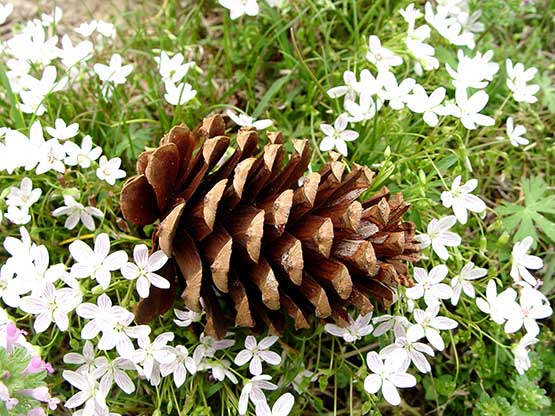RiskVA
Golden Dust and Sneezes. Welcome to Hay Fever Season 22 Apr 2014
Spring is a favorite time of year for me and I thoroughly enjoy the leafing trees and colorful spring flowers. There is only one problem. My eyes itch and I sneeze a lot during this annual event. Since this year’s allergy problems are predicted to be more intense than usual, it’s time to revisit pollen’s story.
>Spring is yellow dust season in east Texas.
Covering cars and outdoor furniture, pollen after a rain often runs in golden rivulets and floats in puddles and ponds. Occasionally you may notice a puff of yellow “smoke” blowing from a pine tree and drifting away on the breeze. Take a close look at the ends of pine branches now and you’ll notice clusters of tiny pollen cones. At the slightest touch or breeze they release clouds of yellow pollen. This is the male half of the partnership required to produce seeds in the cones we usually associate with pines.
Pine Pollen is Not Usually an Allergy Problem
Although pines are the most noticeable source of spring pollen in East Texas, they aren’t alone. Oaks, maples, and other hardwoods, as well as junipers (cedars) and cypresses are also involved, and most of the sniffing, sneezing, and itchy eyes are due to their pollen. Grass pollen and molds also contribute to the misery. Surprisingly, very few people are allergic to pine pollen even though it’s so obvious and heavily produced. Most allergy causing pollen is not easily seen except with a microscope.
What Does Pollen Do for a Plant?
Most of us have looked into a flower and noticed tiny, pollen covered oval structures called anthers standing on graceful stalks. When a grain of pollen falls on the moist stigma – the female reproductive structure of a flower – the grain swells and bursts. A microscopic tube emerges, grows downward inside the stigma and ultimately makes contact with a waiting cell fertilizing it so that a seed can form.
How is Pollen Spread?
In many flowering plants bees provide major assistance in pollen distribution as they wend their way around seeking sweet nectar and pollen to take back to their nests and hives. As they blunder around in a flower, pollen sticks to their fuzzy bodies and is transferred to a flower’s sticky stigma. However, most pollen I’ve mentioned is wind distributed.
Why Do You Sniff and Sneeze?
When allergy-causing pollen grains enter the membranes around the eyes, inside the nose and lungs, they release a protein that results in the production of histamines and other irritating substances. These chemicals produce the typical allergic reaction of red, itchy eyes, runny nose, scratchy throat, sneezing, coughing, sinus congestion, and sometimes asthma attacks. So off we run to the drug store to get anti-histamines. For most of us, these over-the-counter allergy drugs solve the problem, but some people have to undergo a long series of desensitizing injections under the care of a physician. In rare cases, pollen allergies can be life-threatening. Numerous web sites post pollen and allergy levels specific to your area. One of the best is found at www.pollen.com.
Is Pollen Edible?
Some people think so. Pollen collected from bees is one of the oldest known food supplements, dating back to ancient Egypt and China. In a number of cultures it has been thought to prolong youth, and has been referred to as the “ambrosia of the gods.” Hippocrates, the ancient Greek physician sometimes referred to as the father of human medicine, used both honey and pollen as healing agents.
Pollen As a Health Food
Pollen contains a complex mixture of antioxidants and other chemicals including vitamins A, C, and E, lycopene, selenium, and plant pigments called flavinoids, along with amino acids and enzymes. Even today there are those who encourage the use of pollen as a health food. Their claims include weight control, allergy relief, greater strength, improved sexual function, slowed aging, and a strengthened immune system. However, reputable scientific studies are lacking to support most of these grandiose claims.
Nevertheless, many health food stores and some pharmacies sell bee products including pollen capsules and tablets. But please note, I’m not recommending that you rush out to buy any of these preparations without consulting your doctor. People allergic to bee stings should be especially careful not to use these products without the guidance of a physician.
Nevertheless, the yellow rain and bursting buds are a clear indication that spring is upon us; a season – along with sneezes – of comfortable temperatures, rebirth, rejuvenation, and beauty. Enjoy it while it’s here. Soon it’ll be blistering hot summer again.
Dr. Risk is a professor emeritus in the College of Forestry and Agriculture at Stephen F. Austin State University in Nacogdoches, Texas. Content © Paul H. Risk, Ph.D. All rights reserved, except where otherwise noted. Click paulrisk2@gmail.com to send questions, comments, or request permission for use.


